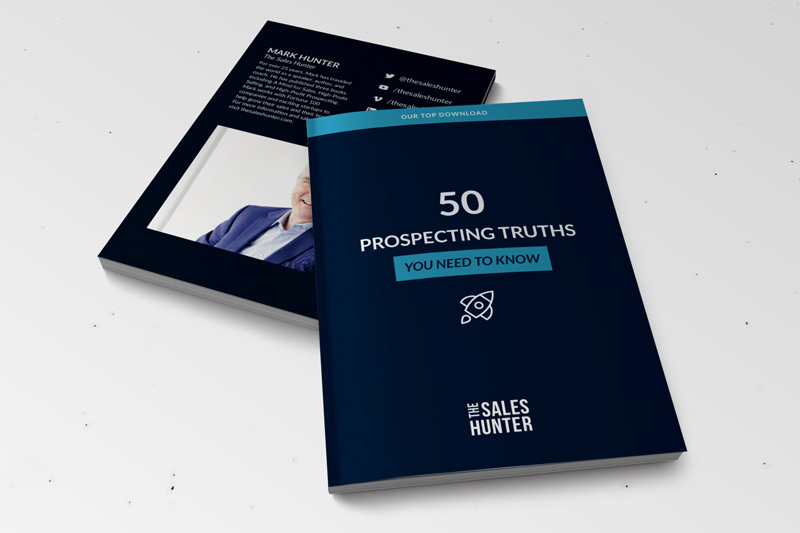Just because something is easy does not mean it is the best solution. Let’s be blunt that email is without a doubt the easiest method to use when it comes to prospecting. There’s a reason why your inbox is flooded with prospecting emails. Anyone can send an email and with the automation tool, anyone can send out 1,000 emails in under a minute; however, just because it’s easy and fast does not mean it works. Open rates are down, and it’s difficult to break through because too many people are making very dumb mistakes. Let me walk you through 10 ways you can make email a much more effective prospecting tool, but first watch this quick video:
How to Use Email to Prospect:
1. Realize email is valuable real estate
Yes, the entire email is valuable, but two parts of it are without a doubt the most valuable. That is the ‘subject line’ and the ‘first six or seven words.’ This is true, because those are the only two parts people see when looking at the email from their smartphone, which is the case with the majority. For me, I base my decision to read the rest of the email off solely those two parts.
Keep both parts tight. Because it’s valuable real estate, the subject line and the first five or six words have got to seriously engage and grab you. Trust me, it won’t work to say, “Hi, my name is …” or “Hi. Let me introduce my company.” No way! Both parts – the subject and the first five or six sentences – must engage the prospect in every way.
2. It’s not show and tell
Too many prospecting emails written by lazy salespeople are nothing but a dumping group where everything is dumped into it. These people think they want to show their prospect everything with hopes that something catches their interest. Unfortunately, all that ends up happening is a bad case of show and tell for the prospect. Hey, this isn’t grade school anymore. Your customers can learn all they want to know about you – and frankly, more – on the internet. It’s not show and tell. What you want to do is inform and pique their interest, yet without giving away too much information to make a decision in order to make sure they talk to you before deciding anything.
3. Email is only one tool
Don’t think for a moment that you’re going to use email as your only prospecting tool – you’re not! If you do think that it’s your only tool, you’ll miss out on a tremendous amount of business. Email is just one of the many tools. There’s also the telephone, social media, text messaging, voicemail, and so many other forms of communication out there today. Use email as one of the tools, but not THE tool.
The number of salespeople I meet who say they rely 100% on email for prospecting frightens me. It amazes me that these same salespeople are often the same ones struggling to meet their quota. There is not a direct correlation between the number of emails sent out by a salesperson and the number of sales made. You can argue with me all you want, but remember the old saying: “even a blind squirrel will find an occasional acorn.” (Sorry squirrels, I didn’t mean to upset you.)
4. Keep it short
The easiest way to keep it short is to see if it passes what I call the one swipe test. What is the one swipe test? It is when you’re able to read the email on your smartphone with only one swipe of your finger. If you can’t read it with one swipe, it’s too long. I talk about this in two of my books, High-Profit Prospecting, and A Mind for Sales. This means your email should not be more than four to six sentences long. Keep it short and the message about them, not you. You’re not writing direct mail copy. Length might work great with direct mail copy and maybe with some other items, but when it comes to prospecting, short always wins.
5. Inform but don’t educate
Now, I talked about this earlier under number two, but let’s dig deeper. What I mean by inform is engage and pique their interest but not as far as to actually educate. If you educate completely, they won’t need you. Save the education piece for when you’re on the telephone with them or face-to-face, when you’re actually in front of them. All you need to do is inform and engage the prospect.
6. Create a CTA
Create a Call To Action (CTA). Too often, salespeople fail to do this. It’s mind blowing the number of prospecting emails I receive that don’t have a prospecting message. What a shame when we’re not creating a prospecting message. It must have a call to action if it’s a prospecting message, one that pulls you back and asks you to do something. Ask a question to engage them. You want them to do something, so prompt them. Don’t simply refer them to a link, that’s never a call to action, just a call to discourage. You want to engage by having them reach out to you.
7. It’s for them, not about you
100% of your email must be focused on them. In fact, I’ll even say a good prospect email doesn’t fully reveal what you do. I don’t care. You just want to pique their interest, so they need to call you. It has to be about them. If the email is about you, why are you sending the email? They can go to a website and get that information. Be careful to not get caught up in what you think is important. The only thing that matters is what the customer / prospect thinks is important. That is whatever they are thinking, and I bet you they’re not thinking about you.
8. Connect the dots
What do I mean by this? Connect the dots on what’s happening in their industry. Connect the dots back to maybe a previous discussion or an inquiry they made to your website. Connect the dots back to maybe one of your webinars that they sat in on. Always connect the dots. This helps show the prospect that it’s not some robotic email but rather a personal email sent to them. That makes them feel cared for.
9. Ban the template
That’s right, ban the template. It’s so easy to get caught up in those one or two or three emails that you like, and you just keep popping them out. It’s easy because you can just change one name on it. No. Let me tell you something – your prospects can see right through that. They can see through that because it’s very quick for you to rationalize away as to why the email is really good. No, all you’re doing is rationalizing away why you don’t want to spend the time to craft a unique, personable email.
10. Personalize it
I don’t mean just add the prospect’s name to it. Anybody can do that! Actually, there’s plenty of programs that can add a name from a database. More than that, you need to personalize it by including something relative to them. The email must contain something pertinent to your prospect, that will connect them. This is key!
Go back through my ten ways to make email a much more effective prospecting tool. Watch my video and stay tuned as I plan to dig into this in future videos. Also, I will dive deeper into this in my online course, The Sales Hunter University. Go check it out! Most of all, grab my books and start reading today, A Mind for Sales and High Profit Prospecting. Then, drop a review on Amazon or wherever you purchased to help spread the word. Buy it, read it, and pass on what you learn!
One final note when it comes to using email for prospecting, don’t think for a moment the results you get will mirror another person’s results just because you use the same email. It’s just not the case. I’ve found far too many variances to say anyone can replicate someone else.












